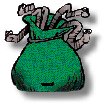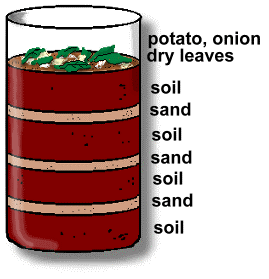
Earthworms are important for the soil. By digging and tunnelling below the surface, they help to mix up the layers, and move nutrients and air from ground level down into the soil. They eat decaying vegetable matter, and their waste is high in nitrates, potash, phosphorus, and magnesium. All these elements are necessary for plant growth.
 Here is a simple spring or fall project you can do, that will demonstrate how good worms really are at turning over the soil. You'll need a large clear plastic pop bottle with the top cut off, some soil, a little sand, a few bits of vegetable and some leaves, and of course, several earthworms. . . Here is a simple spring or fall project you can do, that will demonstrate how good worms really are at turning over the soil. You'll need a large clear plastic pop bottle with the top cut off, some soil, a little sand, a few bits of vegetable and some leaves, and of course, several earthworms. . .
If there's a store in your community that sells bait for fishing, you can buy some worms (they may be called 'night crawlers'), but you can collect your own from your lawn. They appear after a heavy rain, but soapy water also brings them to the surface; look under your clothesline! Or you can make a very mild soap solution (several drops of dish soap in a few gallons of water) and spread the liquid around on a grassy area; worms should appear within an hour or so.
Fill the pop bottle with alternating layers of soil and sand. The soil layers should be 4 to 5 cm thick, the sand layers just 1 cm. Three or four layers of each are enough, but the top layer should be soil. Don't pack the layers ... leave the soil loose.
Sprinkle some bits of vegetable on the surface for the worms to eat. Potato and onion work best. Add a few leaves for cover.
When you drop the worms in, they will begin to tunnel down into the soil. Put the container away in a dark, cool place for several days. You might want to add a perforated cover of some sort if you're worried about the worms making a break for it ...
|

|
While the container is hidden away, the worms will return to the surface over and over, to get food, and in the process, will churn up the layers. When you peek at your worm farm after a few days, the layers of soil and sand will be mixed together; it will be obvious that the worms are thoroughly mixing the soil!
Make sure to release the worms back onto your lawn afterwards.
Resources
HTML, graphics & design by Bill Willis 2023
|

